Vajrasattva: 10 definitions
Introduction:
Vajrasattva means something in Buddhism, Pali, Hinduism, Sanskrit. If you want to know the exact meaning, history, etymology or English translation of this term then check out the descriptions on this page. Add your comment or reference to a book if you want to contribute to this summary article.
Images (photo gallery)
(+18 more images available)
In Buddhism
Tibetan Buddhism (Vajrayana or tantric Buddhism)
Source: Wisdom Library: MañjuśrīnāmasaṃgītiVajrasattva (वज्रसत्त्व) is one of the sixteen samādhi deities appearing in the Vajradhātu-mahāmaṇḍala, according to the Nāmamantrārthāvalokinī v5.32-35. The Nāmamantrārthāvalokinī (literally, ‘an explanation of the nāma-mantras’) is a commentary (ṭīkā) on the 8th century Mañjuśrīnāmasaṃgīti.
Vajrasattva is a name of Mañjuśrī (the embodiement of non-dual knowledge) and, together with other names, forms the core essence of the Mañjuśrīnāmasaṃgīti. The Nāmamantrārthāvalokinī provides the practitioner a sādhana (‘meditative practice’) to turn these names into mantras. These mantras are chanted for the benefit of all beings, and then placed and contemplated in the Vajradhātu-mahāmaṇḍala, which is an extended version of the Vajradhātu-maṇḍala.
Source: Wisdom Library: Tibetan BuddhismVajrasattva (वज्रसत्त्व) is the name of a deity presiding a group of four sacred districts, according to the Abhidhānottarottaratantra and the 9th-centruy Vajraḍākatantra.—Accordingly, Vajrasattva presides over the districts Pullīramalaya (Pūrṇagiri), Oḍyāna (Oḍyāyana), Jālandhara and Arbuda.
Source: Google Books: An Illustrated History of the MandalaVajrasattva (वज्रसत्त्व) is the deity associated with Surata (“pleasure”): one of the Seventeen Viśuddhipadas (“stations of purity”), according to the Prajñāpāramitānayasūtra: an ancient Buddhist Tantric text recited daily in the Japanese Shingon sect which is closely related to the Sarvatathāgatatattvasaṃgraha.—The seventeen-deity maṇḍala, representing the deification of the seventeen viśuddhipadas, corresponds to the great maṇḍala described in the Mahāsamayatattvavajra, which explains seventeen viśuddhipadas (twenty in the Chinese translation). [...] In the Tibetan translation of the prajñākhaṇḍa, the main deity of this maṇḍala is called Buddha, while in both the Tibetan and Chinese translations the deity in front of the main deity is called Vajrasattva.
Source: archive.org: The Indian Buddhist IconographyVajrasattva (वज्रसत्त्व) refers to one of the Dhyāni-Buddhas, according to Vajrayāna or Tantric Buddhism.—His Śakti, or female counterpart (spiritual consort) is named Vajrasattvātmikā and their Bodhisattva offspring is named Ghaṇṭāpāṇi.—His colour is white; his symnol is the vajra and ghaṇṭā.—Vajrasattva, the Sixth Dhyāni Buddha, is regarded by the Nepal Buddhists as the priest of the Five Dhyāni Buddhas. He is not represented in the Stūpa like the other Dhyāni Buddhas, but independent shrines are dedicated to his worship. His worship is always performed in secret and is not open to those who are not initiated into the mysteries of Vajrayāna. Vajrasattva is represented in two forms, single and Yub-yum.
Vajrasattva is described in the Advayavajrasaṃgraha:—“Vajrasattva originates from the syllable HŪṂ and is white in colour. He is two-armed and one-faced and holds in his two hands the Vajra and Vajra-marked Ghaṇṭā. He represents the astringent taste, the Autumn season, the letters of the alphabet ya, ra, la, and va, and the part of the night from midnight to day-break. His second name is Dharmadhātu”.
When represented singly, he is exhibited before the public. The Yab-yum form is generally kept secret. When represented in Yab-yum, he is closely associated with his Śakti who is generally knownas Vajrasattvātmikā. He carries the Vajra and the Ghaṇṭā in thesame manner as when single, but the Śakti holds the Kartri in theright hand and the Kapāla in the left.
Source: Wisdomlib Libary: VajrayoginiVajrasattva (वज्रसत्त्व) is the name of a deity to be contemplated upon by a practicioner purifying his correspondences (viśuddhi), according to the 12th-century Abhisamayamañjarī. The contemplation is prescribed as a preliminary ritual for a yogin wishing to establish, or reestablish the union with a deity.
Vajrasattva is associated with the skandha named vijñāna (consciousness) and the color white. He is to be visualised as standing in the warrior (ālīḍha) stance, having three eyes, matted locks and bearing the five signs of observance (mudrā).
Source: academia.edu: A Critical Study of the Vajraḍākamahātantrarāja (I)1) Vajrasattva (वज्रसत्त्व) is the name of a deity associated with the Skandha (component) named Vijñāna, according to the 9th century Vajraḍākatantra chapter 1.16-22.—Accordingly, this chapter proclaims the purity of the five components (skandha), five elements (bhūta) and five senses (āyatana) as divine beings [viz., Vajrasattva].
2) Vajrasattva (वज्रसत्त्व) is the husband of Mahāvīryā: the name of a Ḍākinī (‘sacred girl’) presiding over Kulatā: one of the four Upaśmaśāna (‘sacred spot’) present within the Kāyacakra (‘circle of body’) , according to the 9th-centruy Vajraḍākatantra. The Kāyacakra is one of three Cakras within the Tricakra system which embodies twenty-four sacred spots or districts resided over by twenty-four Ḍākinīs whose husbands (viz., Vajrasattva) abide in one’s body in the form of twenty-four ingredients (dhātu) of one’s body.
Mahāvīryā has for her husband the hero (vīra) named Vajrasattva. She is the presiding deity of Kulatā and the associated internal location are the ‘knees’ and the bodily ingredient (dhātu) is the ‘snivel’.
Source: academia.edu: The Structure and Meanings of the Heruka MaṇḍalaVajrasattva (वज्रसत्त्व) is the name of a Vīra (hero) who, together with the Ḍākinī named Mahāvīryā forms one of the 36 pairs situated in the Vajracakra, according to the 10th century Ḍākārṇava chapter 15. Accordingly, the vajracakra refers to one of the four divisions of the sahaja-puṭa (‘innate layer’), situated within the padma (lotus) in the middle of the Herukamaṇḍala. The 36 pairs of Ḍākinīs and Vīras [viz., Vajrasattva] each have one face and four arms; they hold a skull bowl, a skull staff, a small drum and a knife; they are dark-bluish-black in color.
Source: OSU Press: Cakrasamvara Samadhi1) Vajrasattva (वज्रसत्त्व) is the name of a Ḍāka (male consort) and one of the deities of the Cakrasaṃvara-maṇḍala or Saṃvaramaṇḍala of Abhayākaragupta’s Niṣpannayogāvalī, p. 45 and n. 145; (Cf. Cakrasaṃvaratantra, Gray, David B., 2007).—The Cakrasaṃvara mandala has a total of sixty-two deities. [...] Three concentric circles going outward, the body, speech and mind wheels (kāya-vāka-citta), in the order: mind (blue), speech (red), and body (white), with eight Ḍākinīs each in non-dual union with their Ḍākas, "male consorts".
Associated elements of Mahāvīrā and Vajrasattva:
Circle: kāyacakra (body-wheel) (white);
Ḍākinī (female consort): Mahāvīrā;
Ḍāka (male consort): Vajrasattva;
Bīja: kuṃ;
Body-part: knees;
Pīṭha: Kulutā;
Bodily constituent: siṅghāṇaka (snot);
Bodhipakṣa (wings of enlightenment): samyagvāc (right speech).
2) Vajrasattva (वज्रसत्त्व) is associated with Vijñānaskandha (“the aggregate of consciousness”), according to the Cakrasaṃvara Samādhi [i.e., Cakrasamvara Meditation] ritual often performed in combination with the Cakrasaṃvara Samādhi, which refers to the primary pūjā and sādhanā practice of Newah Mahāyāna-Vajrayāna Buddhists in Nepal.—Accordingly, “There, in the five aggregates, originates the making of I. Vairocana in the aggregate of forms. Vajrasūrya in sensations. Padmanṛtyeśvara in perceptions. Vajrarāja in mental formations. Vajrasattva in consciousness. Śrī Heruka Vajra in the truth of all Tathāgata”.

Tibetan Buddhism includes schools such as Nyingma, Kadampa, Kagyu and Gelug. Their primary canon of literature is divided in two broad categories: The Kangyur, which consists of Buddha’s words, and the Tengyur, which includes commentaries from various sources. Esotericism and tantra techniques (vajrayāna) are collected indepently.
Languages of India and abroad
Sanskrit dictionary
Source: Cologne Digital Sanskrit Dictionaries: Monier-Williams Sanskrit-English DictionaryVajrasattva (वज्रसत्त्व):—[=vajra-sattva] [from vajra > vaj] m. ‘having a soul or heart of adamant’, Name of a Dhyānibuddha, [Dharmasaṃgraha 3]
[Sanskrit to German]
Sanskrit, also spelled संस्कृतम् (saṃskṛtam), is an ancient language of India commonly seen as the grandmother of the Indo-European language family (even English!). Closely allied with Prakrit and Pali, Sanskrit is more exhaustive in both grammar and terms and has the most extensive collection of literature in the world, greatly surpassing its sister-languages Greek and Latin.
See also (Relevant definitions)
Partial matches: Vajra, Sattva.
Starts with: Vajrasattvadhatu, Vajrasattvadhatulokeshvara, Vajrasattvaguru, Vajrasattvamandala, Vajrasattvatmika.
Ends with: Mahavajrasattva.
Full-text (+183): Vajrasattvatmika, Vanda, Mahavirya, Kancipura, Kuluta, Shinghanaka, Ghantapani, Samantabhadra, Samgrahaka, Samyagvak, Samgraha, Kum, Vajrasattvamandala, Vajraratna, Vajradharmakaya, Vajrasattvaguru, Dvibhuja, Vicitrabharana, Ekamukha, Vajraghanta.
Relevant text
Search found 13 books and stories containing Vajrasattva, Vajra-sattva; (plurals include: Vajrasattvas, sattvas). You can also click to the full overview containing English textual excerpts. Below are direct links for the most relevant articles:
The Indian Buddhist Iconography (by Benoytosh Bhattachacharyya)
Guhyagarbha Tantra (with Commentary) (by Gyurme Dorje)
Introduction 3.2.2: The Sequence of the actual Foundation of Empowerment < [Chapter 9 (Text And Commentary)]
Text 11.12 (Commentary) < [Chapter 11 (Text and Commentary)]
The gods of northern Buddhism (by Alice Getty)
The Practice Manual of Noble Tārā Kurukullā (by Dharmachakra Translation Committee)
Chapter 3 < [Appendix - Sanskrit Text]
Stupas in Orissa (Study) (by Meenakshi Chauley)
Blue Annals (deb-ther sngon-po) (by George N. Roerich)
Chapter 1c - The Zur Geneology (ii): Zur chung shes rab grags pa < [Book 3 - Early translations of Secret Mantra]
Chapter 6 - Accounts of the twenty-for nuns (ma jo) < [Book 12 - Peace-Making Lineages]
Chapter 8 - Later Lineages (iii): The scholar smra ba'i seng ge < [Book 12 - Peace-Making Lineages]
Related products
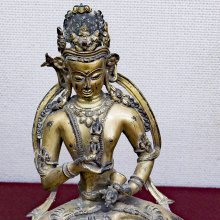
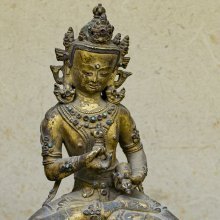
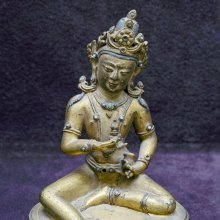
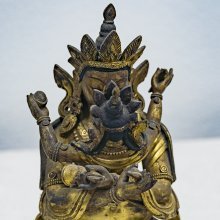
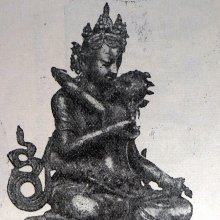
.jpg)
